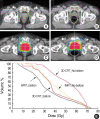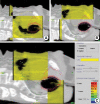Positional reproducibility and effects of a rectal balloon in prostate cancer radiotherapy
- PMID: 19794990
- PMCID: PMC2752775
- DOI: 10.3346/jkms.2009.24.5.894
Positional reproducibility and effects of a rectal balloon in prostate cancer radiotherapy
Abstract
Despite the increasing use of the rectal balloon in prostate cancer radiotherapy, many issues still remain to be verified objectively including its positional reproducibility and relevance to treatment morbidity. We have developed a custom rectal balloon that has a scale indicating the depth of insertion and dilates symmetrically ensuring positional reproducibility. Fifty patients with prostate cancer treated by definitive 3D-conformal radiotherapy (3D-CRT) or intensity-modulated radiotherapy (IMRT) with rectal balloon were analyzed. Each of first five patients undergone computed tomography (CT) three times with a rectal balloon. The positional reproducibility was tested by Intraclass Correlation Coefficient (ICC) from the CT-to-CT fusion images. Planning variables and clinical acute toxicities were compared between when or not applying balloon. An ICC of greater than 0.9 in all directions revealed an excellent reproducibility of the balloon. Rectal balloon improved considerably the mean dose and V(45Gy)-V(65Gy) in plan comparison, and especially in 3D-CRT the rectal volume exposed to more than 60 Gy dropped from 41.3% to 19.5%. Clinically, the balloon lowered acute toxicity, which was lowest when both the balloon and IMRT were applied simultaneously. The rectal balloon carries excellent reproducibility and reduces acute toxicity in 3D-CRT and IMRT for prostate cancer.
Keywords: 3D Conformal Radiotherapy; Acute Toxicity; Prostatic Neoplasms; Radiotherapy, Intensity-Modulated; Rectal Balloon.
Figures





Similar articles
-
Rectal dose sparing with a balloon catheter and ultrasound localization in conformal radiation therapy for prostate cancer.Radiother Oncol. 2003 Jun;67(3):285-94. doi: 10.1016/s0167-8140(03)00056-2. Radiother Oncol. 2003. PMID: 12865176
-
The use of rectal balloon during the delivery of intensity modulated radiotherapy (IMRT) for prostate cancer: more than just a prostate gland immobilization device?Cancer J. 2002 Nov-Dec;8(6):476-83. doi: 10.1097/00130404-200211000-00012. Cancer J. 2002. PMID: 12500857
-
Intensity-modulated radiation therapy (IMRT) for prostate cancer with the use of a rectal balloon for prostate immobilization: acute toxicity and dose-volume analysis.Int J Radiat Oncol Biol Phys. 2001 Mar 1;49(3):705-12. doi: 10.1016/s0360-3016(00)01428-0. Int J Radiat Oncol Biol Phys. 2001. PMID: 11172952
-
Clinical experience with intensity-modulated radiation therapy (IMRT) for prostate cancer with the use of rectal balloon for prostate immobilization.Med Dosim. 2002 Summer;27(2):105-13. doi: 10.1016/s0958-3947(02)00092-4. Med Dosim. 2002. PMID: 12074461 Review.
-
Dose-volume analysis of predictors for chronic rectal toxicity after treatment of prostate cancer with adaptive image-guided radiotherapy.Int J Radiat Oncol Biol Phys. 2005 Aug 1;62(5):1297-308. doi: 10.1016/j.ijrobp.2004.12.052. Int J Radiat Oncol Biol Phys. 2005. PMID: 16029785 Review.
Cited by
-
Effectiveness of a novel gas-release endorectal balloon in the removal of rectal gas for prostate proton radiation therapy.J Appl Clin Med Phys. 2012 Sep 6;13(5):3945. doi: 10.1120/jacmp.v13i5.3945. J Appl Clin Med Phys. 2012. PMID: 22955660 Free PMC article.
-
Impact of rectal balloon-filling materials on the dosimetry of prostate and organs at risk in photon beam therapy.J Appl Clin Med Phys. 2013 Jan 7;14(1):3993. doi: 10.1120/jacmp.v14i1.3993. J Appl Clin Med Phys. 2013. PMID: 23318385 Free PMC article.
-
Dosimetric effects of the acuros XB and anisotropic analytical algorithm on volumetric modulated arc therapy planning for prostate cancer using an endorectal balloon.Radiat Oncol. 2015 Feb 22;10:48. doi: 10.1186/s13014-015-0346-3. Radiat Oncol. 2015. PMID: 25890071 Free PMC article.
-
Clinical effects of rectal retractor application in prostate cancer radiotherapy.Med J Islam Repub Iran. 2021 May 31;35:69. doi: 10.47176/mjiri.35.69. eCollection 2021. Med J Islam Repub Iran. 2021. PMID: 34277506 Free PMC article.
-
Endorectal balloon (ERB) in helical tomotherapy (HT) for localized prostate cancer: a case report of dosimetric analysis.Transl Cancer Res. 2021 Sep;10(9):4250-4255. doi: 10.21037/tcr-21-777. Transl Cancer Res. 2021. PMID: 35116721 Free PMC article.
References
-
- Hanks GE, Hanlon AL, Schultheiss TE, Pinover WH, Movsas B, Epstein BE, Hunt MA. Dose escalation with 3D conformal treatment: five year outcomes, treatment optimization, and future directions. Int J Radiat Oncol Biol Phys. 1998;41:501–510. - PubMed
-
- Pollack A, Hanlon AL, Horwitz EM, Feigenberg SJ, Uzzo RG, Hanks GE. Prostate cancer radiotherapy dose response: an update of the fox chase experience. J Urol. 2004;171:1132–1136. - PubMed
-
- Zelefsky MJ, Leibel SA, Gaudin PB, Kutcher GJ, Fleshner NE, Venkatramen ES, Reuter VE, Fair WR, Ling CC, Fuks Z. Dose escalation with three-dimensional conformal radiation therapy affects the outcome in prostate cancer. Int J Radiat Oncol Biol Phys. 1998;41:491–500. - PubMed
-
- Cahlon O, Zelefsky MJ, Shippy A, Chan H, Fuks Z, Yamada Y, Hunt M, Greenstein S, Amols H. Ultra-high dose (86.4 Gy) IMRT for localized prostate cancer: toxicity and biochemical outcomes. Int J Radiat Oncol Biol Phys. 2008;71:330–337. - PubMed
-
- Vigneault E, Pouliot J, Laverdiere J, Roy J, Dorion M. Electronic portal imaging device detection of radioopaque markers for the evaluation of prostate position during megavoltage irradiation: a clinical study. Int J Radiat Oncol Biol Phys. 1997;37:205–212. - PubMed
MeSH terms
LinkOut - more resources
Full Text Sources
Other Literature Sources
Medical
Research Materials

